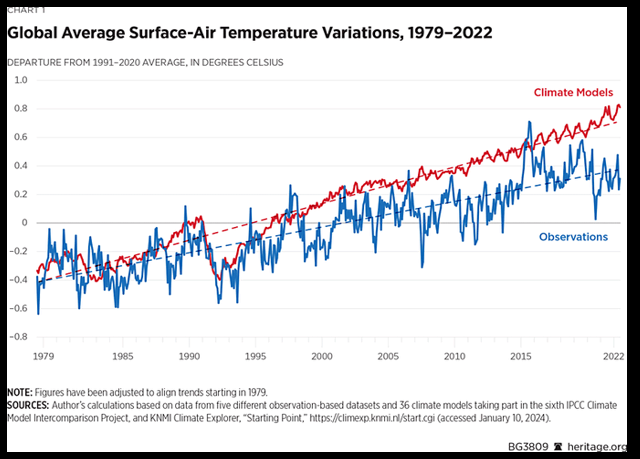Flawed Climate Models Predict More Warming Than Actually Occurs

Dr. Roy Spencer is a Principal Research Scientist at the University of Alabama in Huntsville (UAH) after being a Senior Scientist for Climate Studies at NASA. He is a meteorologist, has published research on various weather and climate problems, and co-developed (with John Christy, UAH) the original method for monitoring global atmospheric temperature variations from Earth-orbiting satellites.
Therefore, Spencer must be considered a true expert on climate, temperature, and temperature measurement issues. He recently published a report for Heritage, which he summarized on the Watts Up With That blog, where he detailedly analyzed recorded temperatures over the last 50 years, comparing those values to those predicted by computer programs.
The flawed climate models have produced warmer temperatures than those measured. Spencer has three key takeaways:
- The real rate of global warming over the past 50 years has been weaker than that predicted by almost all computerized climate models.
- Climate models that guide energy policy do not even conserve energy, a necessary condition for any physically based model of the climate system.
- Public policy should be based on climate observations rather than climate models that exaggerate climate impacts
The entire article is a must-read for those who appreciate good science. However, one section struck me…as it goes to the cherry-picking I noted when describing how only science aligning with political narratives is supported.
Climate models are not only used to predict future changes (forecasting), but also to explain past changes (hindcasting). Depending on where temperatures are measured (at the Earth’s surface, in the deep atmosphere, or in the deep ocean), it is generally true that climate models have a history of producing more warming than has been observed in recent decades.This disparity is not true of all the models, as two models (both Russian) produce warming rates close to what has been observed, but those models are not the ones used to promote the climate crisis narrative. Instead, those producing the greatest amount of climate change usually make their way into, for example, the U.S. National Climate Assessment, the congressionally mandated evaluation of what global climate models project for climate in the United States.
Interestingly, a new study also reveals that Colorado’s climate is much drier than projected by climate models.
The Clausius-Clapeyron Equation shows that water vapor capacity increases by about 7% for every one degree Celsius (1.8 Fahrenheit) of warming.But just because the atmosphere can hold more moisture doesn’t mean it is.“It turns out that in all arid and semi-arid regions of the world, there hasn’t really been a rise in water vapor,” said climate scientist Isla Simpson with the National Center for Atmospheric Research (NCAR). “This is contrary to traditional thinking and a very surprising finding.”She said since places like Colorado and the rest of the southwest U.S. have not seen any additional atmospheric water vapor, they are already about 7% drier than what climate models projected for the current period.
Perhaps it is time for scientists to return to the labs and head to the fields to collect accurate data rather than generate it via software.
For those of you who wish to pursue more on this subject, here is a great lecture given by Spencer on “global warming” (before it became a climate crisis) and policy.
CLICK HERE FOR FULL VERSION OF THIS STORY